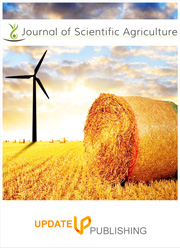Yield performance evaluation of kabuli and desi chickpea (Cicer arietinum L.) varieties under rainfed condition
DOI:
https://doi.org/10.25081/jsa.2024.v8.8964Keywords:
Adaptation, Chickpea, Correlation, Evaluation, Pulse, VarietiesAbstract
Chickpea is one of Ethiopia’s main grain legume crops and it is third most important export legumes after faba bean and haricot bean. The performance information for chickpea cultivars under varying environmental conditions in the Somali region is limited. A field experiment was conducted to test the adaptability of 14 released chickpea varieties (both kabuli and desi types) at Kebribeya and Jigjiga in 2021. The experiment was carried out using a complete randomized block design with three replications for both types separately. The analysis of variance computed for seven traits for each location and over the location revealed the presence of significant variability between varieties. Variety by location interaction was highly significant for most yield and yield related for both types, this indicated that location-specific variety selection is needed. Hence, among the tested kabuli types, Koka and Hora for Kebribeya and Ejera and Koka for Jigjiga were selected based on their grain yield potential and other yield and yield-related traits. Regarding the desi-type Dalota and Dimtu for Kebribeya and Dalota, Natoil and Teketay for the Jigjiga location were the best high-yielder varieties among tested varieties. Additionally, the phenotypic correlation between traits revealed that most traits were associated with grain yield. Specifically, days to maturity and the number of pods per plant were highly correlated with grain yield in both types and were also used as important traits for variety selection. Therefore, the selected varieties from both chickpea types are recommended for popularization in study areas and other similar agroecology.
Downloads
References
Alemu, B., Tesfaye, K., Haileselassie, T., & Lule, D. (2017). Genotype by environment interactions and grain yield stability of released and advanced Desi type chickpea (Cicer arietinum L.) genotypes in western Ethiopia. International Journal of Biotechnology and Molecular Biology Research, 8(3), 30-37. https://doi.org/10.5897/IJBMBR2017.0281
Anbessa, Y., & Bejiga, G. (2002). Evaluation of Ethiopian chickpea landraces for tolerance to drought. Genetic Resources and Crop Evolution, 49, 557-564. https://doi.org/10.1023/A:1021210601480
Bekele, D., Tesfaye, K., Fikre, A., & Cook, D. R. (2021). The extent and association of chickpea Fusarium wilt and root rot disease pressure with the main biophysical factors in Ethiopia. Journal of Plant Pathology, 103, 409-419. https://doi.org/10.1007/s42161-021-00779-4
Climate-Data.org. (2023). Climate data for countries around the world. Retrieved from https://ru.climate-data.org/
CSA. (2017). Agricultural sample survey. Results on the area, production, and yield of major crops in Ethiopia. Addis Ababa, Ethiopia: Central Statistical Authority.
Darkwa, K., Ambachew, D., Mohammed, H., Asfaw, A., & Blair, M. W. (2016). Evaluation of common bean (Phaseolus vulgaris L.) genotypes for adaptation to drought stress in Ethiopia. The Crop Journal, 4(5), 1-10. https://doi.org/10.1016/j.cj.2016.06.007
Dawane, J. K., Jahagirdar, J. E., & Shedge, P. J. (2020). Correlation Studies and Path Coefficient Analysis in Chickpea (Cicer arietinum L.). International Journal of Current Microbiology and Applied Sciences, 9(10), 1266-1272. https://doi.org/10.20546/ijcmas.2020.910.152
FAOSTAT. (2019). Statistics of Food and Agricultural Organizations of the United States, 2019. Retrieved from https://www.fao.org/faostat/en/#home
Fikre, A., & Bekele, D. (2020). Chickpea Breeding and Crop Improvement in Ethiopia: Past, present, and future. Universal Journal of Agricultural Research, 8(2), 33-40. https://doi.org/10.13189/ujar.2020.080202
Funga, A., Tadesse, M., Eshete, M., Fikre, A., Korbu, L., Girma, N., Bekele, D., Mohamed, R., Bishaw, Z., Rao, G., Siambi, M., Monyo, E., Gaur, P., & Ojiewo, C. (2017). Genotype by environment interaction on yield stability of desi type chickpea (Cicer arietinum L.) at major chickpea producing areas of Ethiopia. Australian Journal of Crop Science, 11(2), 212-219. https://doi.org/10.21475/ajcs.17.11.02.p297
Jukanti, A. K., Gaur, P. M., Gowda, C. L. L., & Chibbar, R. N. (2013). Nutritional quality and health benefits of chickpea (Cicer arietinum L.): a review. British Journal of Nutrition, 108, S11-S26. https://doi.org/10.1017/S0007114512000797
Ladizinsky, G. (1975). A new Cicer from Turkey. Notes From The Royal Botanic Garden Edinburgh, 34, 201-202.
SAS Institute. (2020). SAS/STAT Guide for Personal Computers, Version 9. Cary, NC: SAS Institute Inc.
Shumi, D., Alemayehu, D., & Afeta, T. (2018). Adaptation Study of Improved Chickpea (Cicer arietinumL.) Varieties in the middle and highlands of the Guji zone, southern Ethiopia. Academic Research Journal of Agricultural Science and Research, 6(1), 42-46.
Upadhyaya, H. D., Dwivedi, S. L., Baum, M., Varshney, R. K., Udupa, S. M., Gowda, C. L. L., Hoisington, D., & Singh, S. (2008). Genetic structure, diversity, and allele richness in the composite collection and reference set in chickpea (Cicer arietinum L.). BMC Plant Biology, 8, 106. https://doi.org/10.1186/1471-2229-8-106
Varshney, R. K., Song, C., Saxena, R. K., Azam, S., Yu, S., Sharpe, A. G., Cannon, S., Baek, J., Rosen, B. D., Tar’an, B., Millan, T., Zhang, X., Ramsay, L. D., Iwata, A., Wang, Y., Nelson, W., Farmer, A. D., Gaur, P. M., Soderlund, C., ... Cook, D. R. (2013). The draft genome sequence of chickpea (Cicer arietinum) provides a resource for trait improvement. Nature Biotechnology, 31, 240-246. https://doi.org/10.1038/nbt.2491
Published
How to Cite
Issue
Section
Copyright (c) 2024 Yohannes Seyoum Eshetu, Tesfu Mengistu Woldemichael, Zelalem Fisseha Gebreegziabher

This work is licensed under a Creative Commons Attribution-NonCommercial-NoDerivatives 4.0 International License.



 .
.